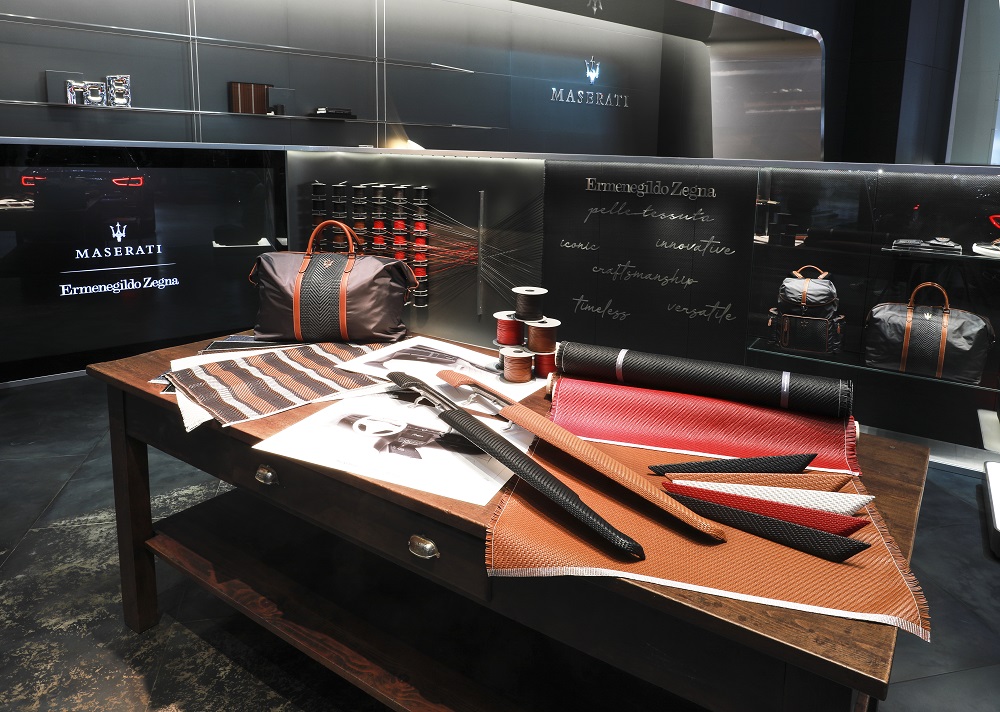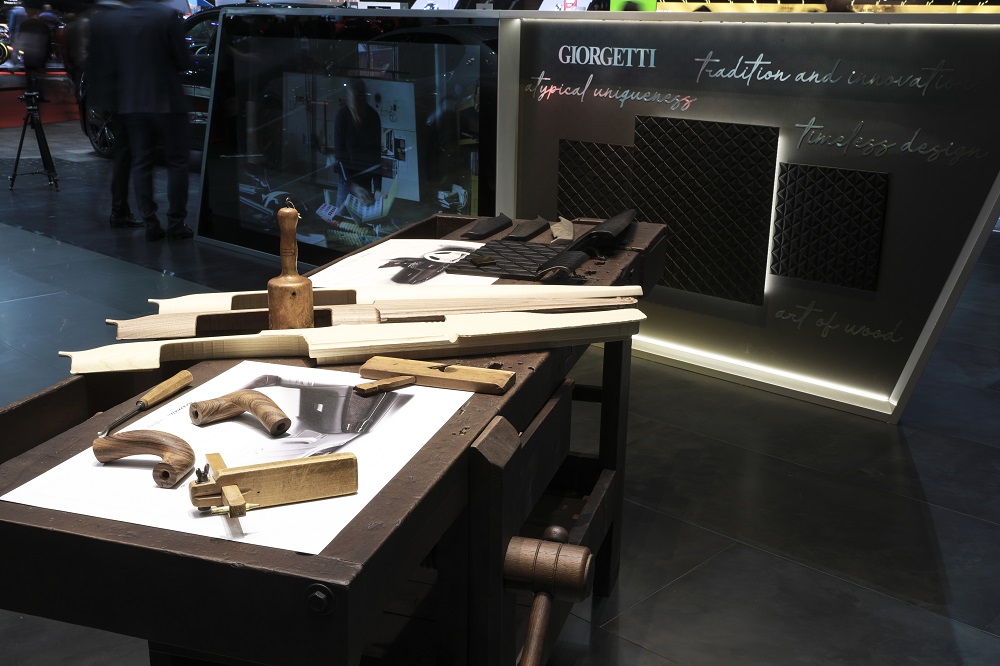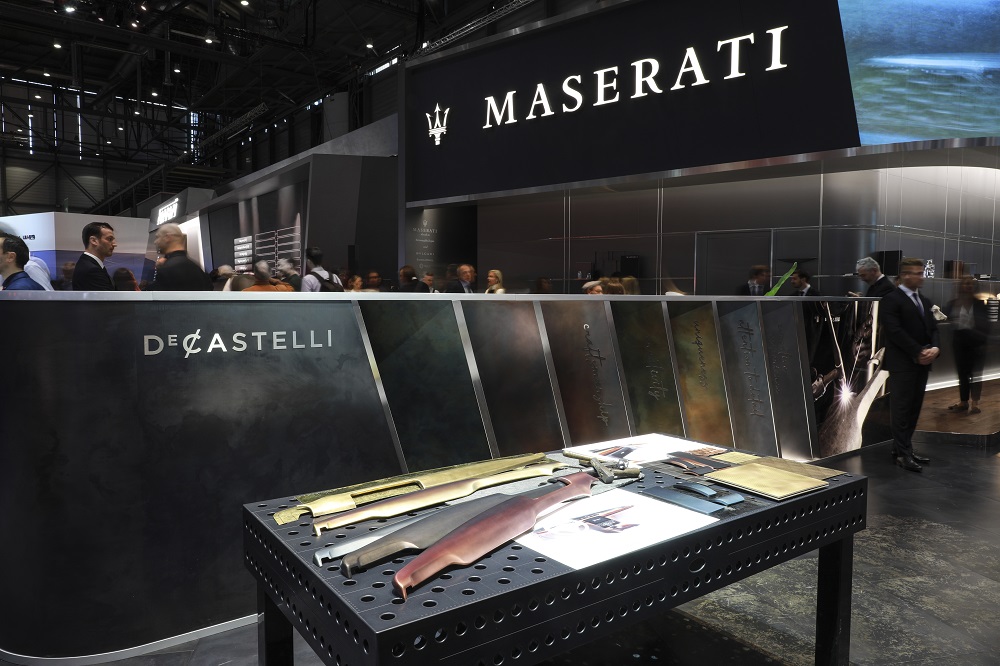Maserati Levante: Antinori’s One of One Revealed in Geneva
Ermenegildo Zegna – Working Table
The Zegna working table illustrates the Zegna-Maserati tailoring atelier, from the preliminary phase of weaving the Pelletessutatm using spools of sturdy bands of leather, through to the rolls of resulting woven material in the Maserati leather colours (black, tan, red and dark brown).
Like a fine, made-to-measure shoe, this Pelletessutatm (woven leather) adapts its shape to the sinuous surface of the Maserati Quattroporte dashboard (the featured element of the interior, over which the Pelletessutatm fits perfectly; the three-dimensionality of the woven strips of leather create a tactile surface for this component, restoring light and texture, imbuing the volume of this component with expressive force). Two Quattroporte dashboard fascias covered with black and tan Pelletessutatm are available to view.
Also on display on the table are five decorative Maserati Levante door panel trim elements, which reveal the opportunities for chromatic customization of the Maserati Pelletessutatm.
The Pelletessutatm tiles represent studies and design research between the Ermenegildo Zegna Style Centre and Maserati, exploring jacquard designs that mix colours, graphic elements and patterns with an eye to potential customizations.
The sketches depict the research carried out by the Maserati Centro Stile into textures, their visual application to the various components and efforts to balance and harmonize colours within the context of the car interior.
Giorgetti – Working Table
The Giorgetti working table features outstanding woodworking and cabinetry skills. By means of three Quattroporte dashboard inserts Giorgetti illustrates the central role of wood when it comes to Maserati components, highlighting how initial mechanical processes are followed by manual ones, operations like precision carving work, turning and modelling in three of the 12 Giorgetti wood varieties: Ash, Walnut and Maple.
The table also features a wooden panel in antiqued Ash with Shibori decorations, the inspiration for the two Quattroporte dashboard fascias which feature this technique in a micro-shibori version, styled and expressed all-over pattern sections. The smallest dashboard inserts feature the same treatment for larger elements on the dashboard in antiqued Ash burl wood and natural Ash burl wood.
Finally, the sheets of veneer complete the table as elements of stylistic research in which Giorgetti and Maserati experiment with wood varieties which are transformed into graphic landscapes in the case of the Ziricote wood, or dynamic textural effects in the case of the Tanganika Frise.
De Castelli – Working Table
The working table illustrates the meeting between the Italian excellence of De Castelli, when it comes to creative metal surfacing, and Maserati’s eagerness to embrace and interpret this poetry in metal. The sophistication of the metal working processes applied to its interior components (the dashboard fascia and the pedal trims) serves to further enhance the interior, not only functionally but also by introducing a sense of poetry and textural allure. A storytelling inspired by the chromatic richness of the Italian sea- and landscape.
The four sheets of metal demonstrate the process of working the semi-finished material. The sheet of raw material in its pure form is subjected to a manual hammering phase, fashioning it into the shape of the Maserati Quattroporte dashboard. The featured element of this interior, is perfectly suited to communicating the subtle chromatic and poetic transitions of the DeMarea finish, selected for this exquisite work of art. The other two elements illustrate the phases of oxidation and surface transformation of the brass: human manuality, creativity and sense of aesthetic pleasure decide when to stop time and halt the process of oxidation, ascertaining the perfect moment for obtaining the DeMarea gradient. This process is simply defining the uniqueness of each detail.
On the artisan’s working table and creative space, the process of storytelling unfolds with the help of tools or historical instruments, where metal sheet is shaped into a work of art.
Subjected to various surface treatments, the sheets of metal convey the excellence of the De Castelli world, not to mention Maserati’s flair for design.
The working table also displays a Quattroporte dashboard fascia with the DeMarea Iron, DeMarea Copper and DeMarea Brass finish. The DeMarea trilogy illustrates a single process composed of superimposed, polysemous manual oxidation operations. These are all inspired by Italian sea- and landscapes, creating “watercolour” effects, conveying highly textural sensations and evocations of waves lapping against Venice’s signature mooring posts.
The collaboration between De Castelli and Maserati also expresses itself in the pedals. These key elements for operating a car have been embellished with a hand-applied oxidation treatment, boasting a more sophisticated flair in the DeMarea Copper kit, combined with the luxurious pad in vegetable-tanned Saddle Extra leather, which is inspired by the soles of made-to-measure shoes. While a more “art workshop” flair distinguishes the DeMarea Iron kit, brandishing logos engraved with the Maserati name
The sketches depict the research carried out by the Maserati Centro Stile into textures, their visual application to the various components and efforts to balance and harmonize colours within the context of the car interior.



